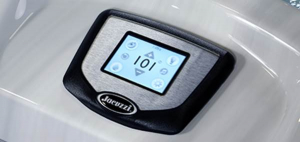Whether you enjoy soaking in a hot tub or relaxing in a sauna, the therapeutic benefits found in both can be helpful to one’s overall health and well-being. Below we compare the health benefits of warm water therapy and dry heat therapy.
What is an Infrared Sauna?
An infrared sauna is an enclosed “room” that use heat and light to help relax and detoxify the body. You may hear some people refer to saunas like this as far-infrared-saunas; meaning, the location of the infrared waves on the light spectrum are “far”. The dry heat in the air is what warms your body and makes you sweat. Sizes vary from 1 person to 6+ person units.
What is a Hot Tub?
A hot tub or spa is a tub filled with water that is heated with jetting to move and circulate water and air (i.e. bubbles), and is used primarily for hydrotherapeutic relaxation. Spas vary in size and seating capacity from 1 person to 8+ person, and vary in shape, color, and other aspects.
How do Hot Tubs & Infrared Saunas Differ?
Similarities:
- Relax muscles
- Remove tension in the body
- Increase blood circulation to help soothe muscle/joint aches and pains
- Raise heart rate to simulate mild exercise
- Increase deep sleep
Differences:
Hot Tubs:
- Release pain reducing endorphins throughout the body to help relieve immediate pains and aches
- Help type 2 diabetes patients by decreasing blood sugar levels
- Increase productivity of digestive system over time
Infrared Saunas:
- Detoxify and improve immune system function
- Rejuvenate your skin, clearing out rashes and acne
- Improve overall skin tone
*No warranty, express or implied, is made as to the accuracy of the above information. Do not deem any of the information provided as a specific recommendation or a means of diagnosis, prognosis, or treatment prescription. Please consult your medical provider before using warm water immersion/hydrotherapy or dry heat therapy for medical conditions.









